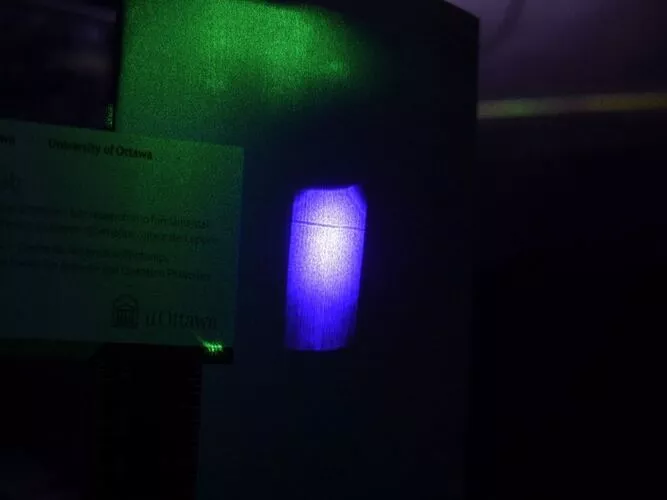In a groundbreaking study, researchers have achieved what was long thought impossible: creating a visible shadow with a laser beam. This phenomenon, observed using a ruby crystal and dual laser setup, challenges foundational concepts in physics and opens new doors in optics and photonics.
“Laser light casting a shadow was previously thought impossible since light usually passes through other light without interacting,” research team leader Dr. Raphael A. Abrahao from Brookhaven National Laboratory said in a release. “Our demonstration of a very counterintuitive optical effect invites us to reconsider our notion of shadow.”
Traditionally, light is considered massless and incapable of casting shadows. However, in findings just published in the journal Optica, an international team of scientists has demonstrated that a laser beam can cast a shadow—an achievement that redefines the relationship between light, matter, and optical phenomena.
Using a high-power green laser beam and a nonlinear optical process in a ruby crystal, the team created shadows that can be seen with the naked eye, much like those cast by solid objects.
The breakthrough is a testament to the peculiarities of nonlinear optics and the unique properties of materials like ruby. The researchers revealed how the intricate interplay between photons and the crystal’s atomic structure enables the light from one laser to block another, creating a shadow effect.
Shadows, as traditionally understood, are caused by opaque objects blocking light. This new discovery flips that notion on its head.
In the experiment, a green laser beam passed through a ruby crystal while a perpendicular blue light illuminated the setup. The interaction within the crystal caused the blue light’s transmission to decrease wherever the green beam was present, producing a shadow-like effect.
In their paper, researchers explained that the shadow produced in experiments is not light blocking other light but a complex interaction between photons and the ruby’s unique atomic structure. The ruby acts as a medium that enables this unprecedented behavior.
This phenomenon, known as reverse saturation of absorption, allows the material to absorb more light at higher intensities rather than becoming more transparent—a counterintuitive behavior critical to producing the shadow.
The laser shadow mimics all the hallmarks of a traditional shadow. It follows the shape of the beam, contours around objects, and moves as the beam’s position changes. Experiments demonstrated that the shadow was even measurable in contrast, reaching intensities comparable to shadows cast by physical objects.
“We experimentally measure the dependence of the contrast of the shadow on the power of the laser beam, finding a maximum of approximately 22%, similar to that of a shadow of a tree on a sunny day,” researchers explained.
The key lies in ruby’s unusual optical properties. When the green laser passes through the ruby, its photons excite specific energy levels within the crystal. This excitation alters the crystal’s absorption characteristics, selectively blocking portions of the blue illumination beam. The result: a darkened area resembling a shadow.
The researchers quantified the effect using mathematical models and advanced imaging techniques. Their findings aligned closely with theoretical predictions, solidifying the experimental results and highlighting the robustness of the laser shadow phenomenon.
This discovery isn’t just a scientific curiosity—it has potential real-world applications. By controlling light with light, researchers foresee uses in optical computing, precision imaging, and advanced fabrication techniques.
“Our understanding of shadows has developed hand-in-hand with our understanding of light and optics,” Dr. Abrahao said. “This new finding could prove useful in various applications such as optical switching, devices in which light controls the presence of another light, or technologies that require precise control of light transmission, like high-power lasers.”
Moreover, the ability to cast shadows with laser beams might revolutionize fields like lithography and 3D imaging. By fundamentally manipulating light’s behavior, scientists can envision creating intricate patterns or images without physical stencils.
The breakthrough challenges long-standing assumptions about the nature of light and shadows. While photons—the particles of light—are massless and typically pass through one another without interaction, this experiment shows that light can behave as if it has mass, casting a shadow under specific conditions.
So, while shadows have always been associated with matter, these findings could change that perspective entirely, showing that light can mimic a physical object’s behavior. “This discovery expands our understanding of light-matter interactions and opens up new possibilities for utilizing light in ways we hadn’t considered before,” Dr. Abrahao added.
The researchers plan to explore whether other materials, such as alexandrite, can replicate the effect and investigate its potential scalability for industrial applications. They also aim to refine their theoretical models to better understand the underlying physics.
Ultimately, the discovery is more than a scientific novelty. It could represent a shift in understanding of light’s interaction with the world. As researchers continue pushing the boundaries of optical science, the possibilities for innovation could be limitless.
“This experiment redefines our understanding of what a shadow is—under the right conditions, laser beams can cast a shadow,” researchers concluded. “Potential applications can be envisioned in areas such as optical switching, controllable shade or transmission, control of the opaqueness of light with light, and lithography.”
Tim McMillan is a retired law enforcement executive, investigative reporter and co-founder of The Debrief. His writing typically focuses on defense, national security, the Intelligence Community and topics related to psychology. You can follow Tim on Twitter: @LtTimMcMillan. Tim can be reached by email: tim@thedebrief.org or through encrypted email: LtTimMcMillan@protonmail.com

